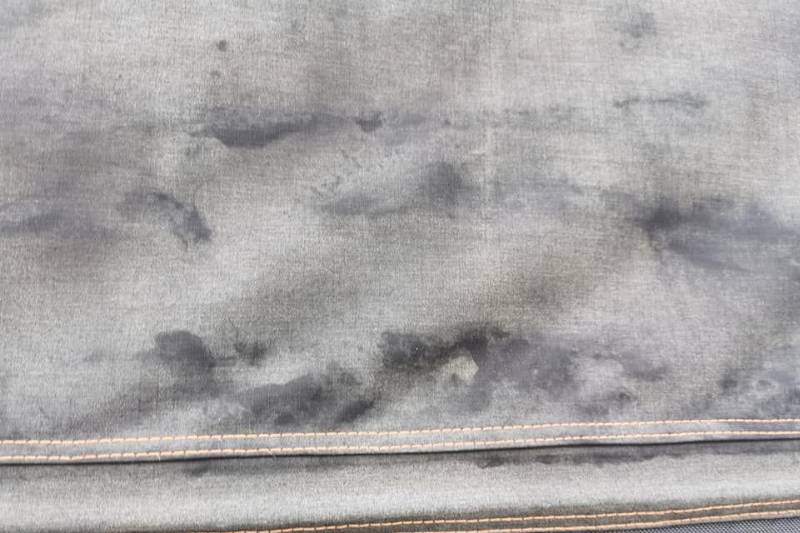What Are Tents Made Of: Which is the Best
Tents have evolved significantly from their humble beginnings, with advancements in material technology playing a pivotal role in their transformation. Tents are made from various materials from polyester to good old cotton. Choosing the right material for your tent can make a significant difference in your outdoor experience.
It’s not just about finding a shelter that keeps you dry and protected; it’s also about finding one that balances durability, weight, and functionality to suit your specific needs. Tent fabric also influences how heavy, tear-resistant, and waterproof the tent is.
In this guide, we’ll explore the different types of tent materials, their unique characteristics, advantages, and potential drawbacks. By the end of this exploration, you’ll have a clearer understanding of which tent material aligns best with your outdoor aspirations.
Polyester
Polyester (PES) is made from plastic granules that are melted and then spun into fibers. These fibers are 3 times finer than silk. Most family tents, camping tents, shade sails, and tarps are made of polyester. The good reason is that polyester is the “egg-laying woolly milk pig” among tent materials.

Properties
Synthetic fiber polyester is light, robust, and easy to process. Therefore, tents made of Synthetic fiber polyester are often available at an attractive price. Polyester has a high tear and abrasion resistance. This is important when the wind pulls on the tent: it does not tear, even with strong gusts. Thanks to its high abrasion resistance, the tent floor resists dust and fine sand for a long time.
Polyester does not absorb much moisture, so the tent dries quickly after a downpour. When dismantling and packing your tent, you should dry it as well as possible so that the material is not attacked by permanent moisture and mold.
The high tear resistance has another advantage: you can use a thin tent fabric for the tent. However, a polyester tent is a little heavier than a nylon one, but significantly lighter than a cotton tent. The pack size is also small and they can easily find a place in your hiking backpack.
However, the thin fabric hardly insulates against the sun’s heat or cold. Thicker fabrics such as cotton fabrics can do this better. Polyester is quite stiff and not very stretchable. And the result: the tent looks a bit crumpled in the first few hours after unpacking. That will change over time.
Polyester tent rustles comparatively strongly in the wind. This can be a bit noisy when you want to sleep. However, polyester does not stretch when wet and sag when it rains. So users don’t have to tighten the tent when it rains.
Coating
Polyester tent insulates well and remains flexible even in the cold. Thanks to the polyurethane coating, it is completely waterproof. High water columns of 5,000 mm and more are not uncommon. However, PU-coated polyester is not breathable. To avoid the formation of condensation, the tent should have ventilation flaps. Because polyurethane is sensitive to heat and UV radiation, only the inside of the tent material is usually coated. The outside is protected by impregnation.
Maintenance
Polyester tent is easy to care for. Unlike cotton, polyester does not rot when exposed to moisture and is mildew resistant. So it’s not so bad if you pack the tent when it’s damp. Nevertheless, you should unpack the tent again after a few days at the latest to dry it. Otherwise, ugly mold stains can form on the tent material.
Also, the polyurethane coating is susceptible to hydrolysis. During hydrolysis, water penetrates the coating. The protective layer slowly dissolves and eventually peels off. This only happens after a few months; the wetter and warmer it is, the faster the hydrolysis progresses.
If the polyester canvas gets dirty, you can often clean it with warm water and a cloth. For stubborn dirt, you can use a little washing-up liquid or a tent cleaner suitable for coated fabrics. However, strong detergents, hard brushes, and washing machines are taboo!
It makes sense to re-impregnate the outside of the tent fabric about every 2 years after cleaning with detergents. You can use our guide. This prevents dirt from penetrating the fabric and increases the lifespan of your beloved tent.
Lifespan
Polyester tent fabric has a limited lifespan. Common causes of this are abrasion from sand, aggressive soiling with bird droppings or sunscreen, hydrolysis, and above all UV radiation. If the tent is left in the sun, the material can be significantly damaged due to UV radiation. The first sign: the colors are getting pale. This is a purely visual problem and does not affect functionality.
At some point, the polyurethane coating will become brittle and brittle. Then water can seep into the tent through small cracks. Finally, polyester feels like paper and tears very easily. This usually happens when there is a strong gust of wind or when you close a zipper.
Advantages & Disadvantages
Advantages:
- High tear and abrasion resistance.
- Easy to care for and does not rot.
- Inexpensive and mildew resistant.
- Do not stretch when wet.
- No re-tensioning is required.
- Lighter than cotton and tents pack small.
- With coating, the fabric is completely waterproof.
- Dries quickly after rain and is easy to clean.
Disadvantages:
- Slightly heavier than nylon.
- Insulates only slightly against heat and cold.
- In strong wind, polyester produces flapping noises.
- Polyurethane coating is sensitive to UV radiation.
Nylon
Nylon is a polyamide (PA) that is synthetically produced from air, water and carbon. It is extremely light but still stable in extreme weather. That is why high-quality trekking and expedition tents are made of nylon.

Properties
Nylon is more elastic, stronger, lighter, and more durable than PU-coated polyester. It copes excellently with moisture: nylon does not rot or mold. Nylon tents are even lighter than polyester and have smaller pack sizes. In high winds, nylon can stretch better than polyester. That’s why nylon tents are particularly good at surviving a storm.
Unfortunately, nylon also stretches when wet. That’s why nylon tents occasionally need to be tightened after a downpour so that the tent fabric doesn’t sag. To improve wet stretch and tear resistance, nylon fabrics are often sewn into a grid pattern of extra-strong threads (ripstop). In most cases, the manufacturer also applies a silicone coating to the tent material. The cloth is then absolutely waterproof.
Coating
Nylon fabric is often coated with silicone. Thanks to silicone, it is waterproof, very elastic, and well-protected against UV radiation. Good UV protection is an important advantage compared to PU-coated polyester. Silicone-coated nylon is very smooth. This is ideal in winter – snow slides off the tent easily. However, a silicone tent floor is also quite slippery.
Unfortunately, a silicone coating is more expensive and complex than a PU coating. And because silicone is so smooth, tent seams cannot be glued with seam tape. Each seam must be sealed with a silicone-based seam sealer. Because silicone-coated nylon is so light and strong, you can find this material in high-quality ultralight backpacking tents.
Maintenance
Nylon tent fabric is even easier to care for than the easy-care polyester tent material. Silicone-coated nylon will not rot when wet and is highly mold resistant. Unlike polyurethane, the silicone coating is resistant to hydrolysis. Unpack your damp nylon tent within a few days to prevent odors.
The smooth nylon canvas repels dirt very well. You can easily clean most dirt with warm water and a cloth. For stubborn stains, you can use a little washing-up liquid or a tent cleaner suitable for coated fabrics. However, strong detergents, hard brushes, and washing machines are taboo! You should re-impregnate it about every 2 years. Nylon is more stretchy and often more tear-resistant than polyester, so the tent fabric forgives many mistakes when tensioning the tent.
Lifespan
The lifespan of a nylon tent depends on how you use the tent. The same applies to polyester tent fabric: Abrasion from sand, soiling from bird droppings or sunscreen, and UV radiation reduce the lifespan of your tent. In our experience, silicone-coated nylon lasts longer than polyester. The silicone coating protects the tent from UV radiation and is not at risk of hydrolysis.
You can renew the silicone coating yourself at any time with a silicone-based impregnation agent! It is also possible to reseal small damages in the tent fabric with silicone. With good care, you can enjoy your tent for many years.
Advantages and Disadvantages
Advantages:
- High abrasion resistance and good tear resistance.
- It does not rot and is mildew-resistant.
- Nylon is even lighter than polyester.
- Tents have a small pack size.
- Coated nylon is 100% waterproof.
- Good protection against UV radiation.
- Easy to care for and easy to clean.
Disadvantages:
- Absorbs some moisture and stretches in the process.
- Hardly insulates against heat and cold.
- More expensive than polyester tent fabric.
Ripstop Nylon
Ripstop nylon features a grid of strong threads woven into the fabric, boosting its tensile strength and reducing stretch from moisture. The thicker threads prevent small tears from spreading, while the thin material remains lightweight and compact for easy packing.
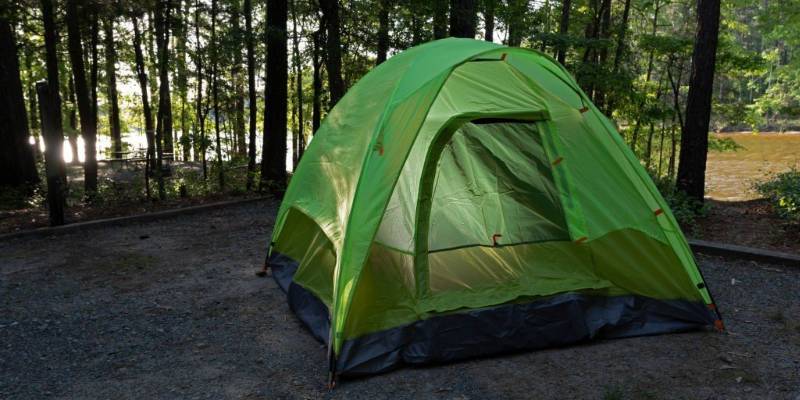
Advantages and Disadvantages
Advantages:
- Significantly more tear-resistant than nylon.
- It has much less stretch when wet than nylon.
- Lightweight and easy to carry on backpacking trips.
- Dry relatively quickly compared to other materials.
Disadvantage:
- Slightly more expensive than regular nylon.
- Not breathable like some natural fabrics.
Cotton
Cotton is a natural, breathable fiber from the cotton plant, making tents comfortable in hot weather. Due to its weight, it’s mainly used in stationary tents like family tents, caravan awnings, and pavilions.
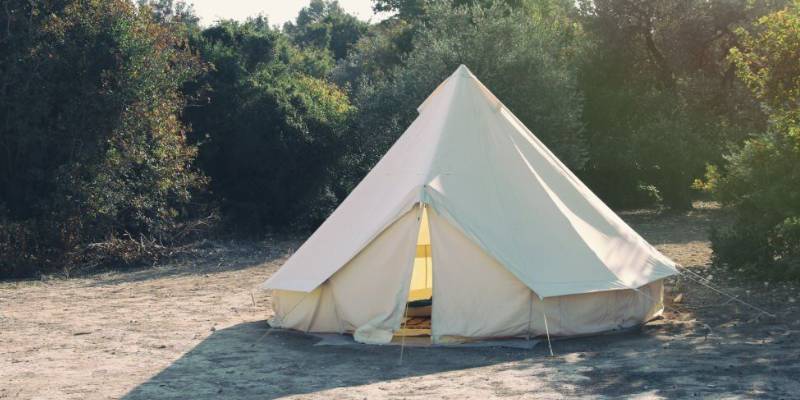
Properties
Natural fiber cotton has a big advantage over synthetic fibers. Cotton is breathable and pleasant in cold weather. That is why the climate in the tent is pleasantly fresh when it is hot. Cotton is comparatively thick, insulated, and noticeably warmer in the tent than lightweight synthetic fiber tents. In damp weather, no condensation forms inside of the tent. That’s why cotton tents don’t have an inner tent.
As a natural fiber, cotton has excellent protection against UV radiation. However, this fabric will fade over time. It does not become brittle and fragile. That is why cotton tents have a particularly long lifespan. Sensitivity to moisture is the disadvantage of cotton. Cotton tents are also significantly heavier than synthetic fiber tents and have a larger pack size.
- Lightweight cotton tent fabric for small tents weighs 120 – 200 g / m².
- Medium-weight cotton tent fabric for large tents weighs 200 – 260 g / m².
- Heavy tent material for group tents and awnings weighs 260 – 400 g / m².
Cotton tents dry comparatively slowly after a downpour. If you have packed the tent while it is damp, you have to unpack it to dry after a few days at the latest. Otherwise, mold stains and mold will form in the fabric. Your tent also needs regular maintenance to ensure it lasts in wet weather.
Cotton tents are relatively more expensive. In return, a cotton tent can accompany you on your tours for a very long time. One last advantage should not go unmentioned: The thick cotton cloth does not rustle in the wind. This promotes restful sleep.
Coating
Cotton doesn’t need a coating. If cotton tent fabric gets wet, fibers swell and fabric naturally seals itself. The tent is then waterproof. However, with the first raindrops, a fine mist may sometimes pass through the tent fabric before it fully seals itself. Cotton fabric soaks up with water, so make sure that no water-sensitive objects touch inside the tent material. Cotton tents are impregnated to protect against mould, mold stains and UV radiation.
Maintenance
Cotton tent must be dry when you pack because the material dries comparatively slowly. If you are still damp when packing the tent, unpack it to dry after a few days at the latest. Otherwise, mold stains and mold will form in the tent material. You can no longer remove the black spots and the musty smell. In severe cases, the fabric will rot and need to be replaced.
The manufacturer impregnates the tent fabric with a water-repellent impregnation agent so that this thing doesn’t happen so easily. The protection is retained if you regularly re-impregnate the cotton tent according to instructions. To further minimize the risk of mold, keep the tent clean. Regularly remove stains and dirt with a soft brush and some water.
Some tents are not yet waterproof when delivered. Cotton therefore needs more care than tent material made of synthetic fibers. On the other hand, a well-maintained cotton tent can accompany you for many years.
Lifespan
Cotton tent fabric has a longer service life than synthetic fiber fabric. There are two reasons for this: cotton tent cloth is comparatively solid and resistant to UV radiation. Light cotton fabric (small cotton tents) will last about 100-300 days. Medium-weight cotton fabric (large cotton tents) has a lifespan of about 150-350 days. Heavy cotton fabric (group tents and awnings) can last 200-500 days.
Advantages and Disadvantages
Advantages:
- Breathable – no condensation in the tent.
- Good insulation and is warm when it is cold.
- Long service life thanks to natural UV protection.
- Cotton doesn’t rustle in the wind.
- Don’t need an inner tent.
- Waterproof with good care.
Disadvantages:
- Expensive.
- May stain and mold when wet.
- Comparatively heavy and has a large pack size.
- Regular care (cleaning, impregnation) is required.
Poly-cotton (blended fabric)
Poly-cotton is a mixture of cotton and polyester. This blended fabric is lighter and more stable than cotton. This fabric dries faster and is more tear-resistant than cotton. Also, poly-cotton is breathable and has a longer lifespan than polyester. The mixing ratio of the individual materials determines the properties of the mixed fabric. Poly-cotton often consists of 70% cotton and 30% polyester.
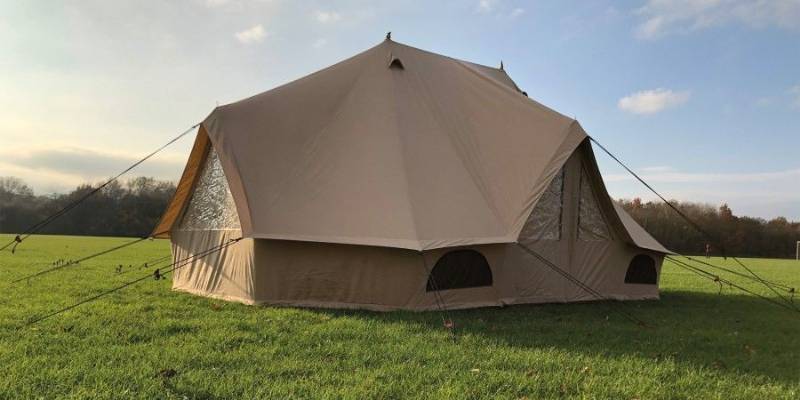
Advantages and Disadvantages
Advantages:
- Tear-resistant and dries faster than cotton.
- Breathable and lighter than pure cotton.
- Longer service life than PU-coated polyester.
- Good climate inside the tent.
Disadvantages:
- Must be well cared for
- Comparatively high price
Cuben Fiber (Dyneema)
Cuben fiber is an ultra-strong polyethylene fiber, using a patented gel rotation process. It was originally developed for the sails on racing yachts. It is lightweight, windproof, waterproof, and has a high energy absorption capacity with very low elongation.
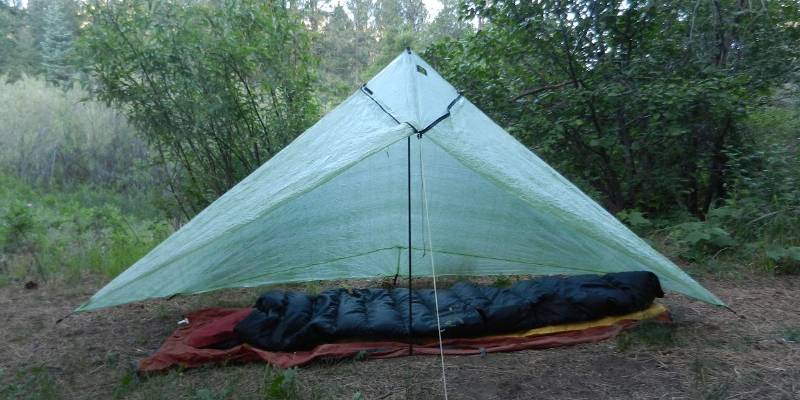
Cuben Fibe or Dyneema fabric has incredible tensile strength for its weight. This synthetic composite fabric is also extremely resistant to abrasion, humidity, UV rays, and chemicals. Dyneema ropes are currently the strongest in the world. This type of tent is easy to puncture with a buckle or hiking pole or whatever.
However, cuben fiber is a lot more expensive than other tent fabrics. That’s why Dyneema tent is more expensive than others, even the price can even double sometimes. Also, cuben fiber tents are not always comfortable and often don’t have a groundsheet. These designs may pack down to the size for comfortable carrying but might not keep you as warm and dry as other shelters.
Which Tent Material is Best for You?
It entirely depends on the purpose of use. You know every tent fabric has good and bad properties. And you have to decide which qualities are most important to you. However, for short camping trips on commercial campsites or at festivals, we recommend a polyester tent.
For hiking, the high-end polyester or silnylon model should be fine. We recommend nylon for tents that are frequently set up and dismantled or carried over longer distances. The tent fabric is much lighter than cotton; you can pitch the tent more easily and quickly on a weekend trip.
Cotton and poly-cotton tents can be ideal if you need to stand in the same place for a long time. The reason is: Cotton has good thermal properties and is very comfortable in a tent. However, this material is quite heavy. But that’s not a problem if you don’t have to carry the tent over long distances.
Cuben fiber fabric tent canvas could be a wise choice for backpackers and long-distance runners. But its fragility can make it a riskier option for longer or more remote trips.
Conclusion
The choice of material for tents plays a crucial role in determining their durability, weight, weather resistance, and overall performance. Consider factors such as climate, terrain, and trip duration before buying. It’s also important to invest in quality craftsmanship and proper care to extend the lifespan of your chosen tent material.
Remember, no single material is superior in all aspects, so a thoughtful evaluation of your camping style and requirements will lead you to the material that best suits your adventures.
Happy camping!
If you still have questions, we will be happy to answer them.



